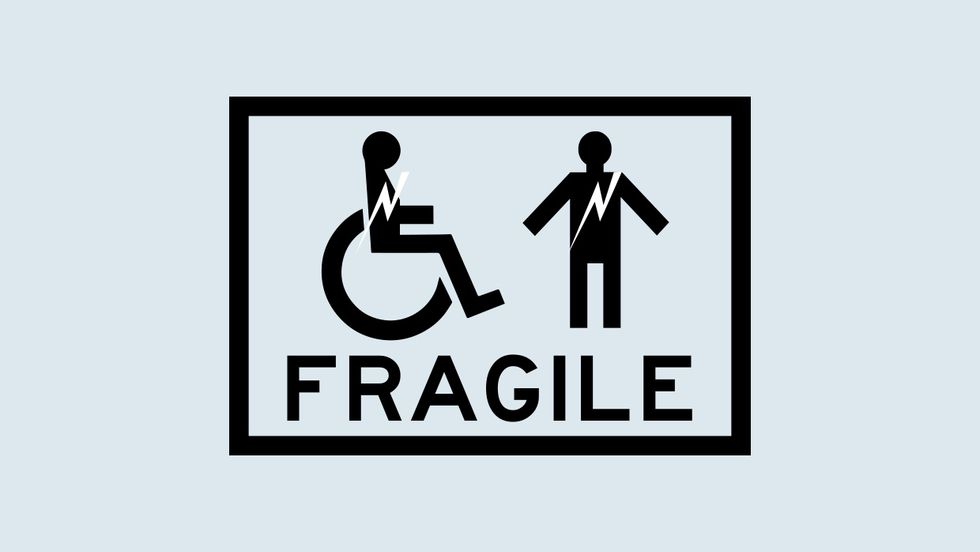The Americans with Disabilities Act (ADA 1990, amended 2008) considers a person to have a disability if she or he has a significant impairment that interferes with a major life activity, such as walking, seeing, hearing, learning, speaking, breathing, standing, lifting, or caring for one's self. The ADA covers both physical and mental impairments, such as mental retardation, orthopedic, hearing, visual, speech, or language impairment, emotional, disabilities, learning disabilities, autism, traumatic brain injury, attention deficit disorder, depression, mental illnesses, (such as bipolar disorder, or schizophrenia) environmental illnesses and chronic illnesses such as diabetes, HIV/AIDS, cancer, and epilepsy. The global population of people with disabilities is growing, due to aging, ethnic and sectarian violence, war, poverty, and the contamination of the environment.
"Ableism," or disability oppression, is a term used to describe the all-encompassing system of discrimination and exclusion of people living with disabilities. Similar to other forms of oppression, ableism functions on individual, intuitional, and cultural levels to advantage people who are temporarily able-bodied and disadvantage people with disabilities.
We use the term, "temporarily able-bodied," to raise consciousness that people who do have disabilities may become disabled by illness, the process of growing older, accidents, and war.
The term "handicapped" emerged in England from people with disabilities who used their cap in hand on street corners to plead for money. Early Western medical textbooks classified people with disabilities as "genetically defective." The medical goal was to "cure" the disability, get rid of a deformity, fix the body, and/or numb the existing pain of the person who was described as the "patient." This thinking and methodology resulted in solutions that were invasive usually by surgery or drugs, and which required submission from the person with a disability. The view that disabilities are deficiencies that require medical treatment and repair remains pervasive today.
The power of the early-nineteenth-century Eugenics movement spurred policies to segregate and sterilize people considered to be hopelessly unredeemable because of their disabilities. "Eugenics" as a movement was coined in 1883 in England by Sir Francis Galton, a cousin of Charles Darwin. Eugenic derived from the Greek word "well-born" or "of good origins or breeding," and it became the "science" of supposedly improving qualities of a so-called "race" by controlling human breeding. Eugenics at its most extreme became the "scientific" rationale for Germany's genocidal policies during World War II in which thousands of people with mental or physical disabilities (as well as members of supposed "lower races," for example Jews, Poles, and other groups, such as homosexuals) were shot, gassed, or left to starve to death.
On September 25, 2008, the ADA was amended, thereby expanding the definition of disability. The new regulation better defines the term "substantially limits" and expands the definition of "major life activities." For example, learning, reading, concentration, thinking, communicating, and working is now recognized as major life activities. Also added to the law are major bodily functions, such as functions of the immune system. The amended ADA further states that conditions that are episodic or in remission may be labeled as disabilities when the active impairment can substantially limit a major life activity.
In addition. the Education for All Handicapped Children Act of 1975, mandated that all children should receive a "free, appropriate public education" in the "least restrictive environment." Colleges have seen an increase in the number of students with autism spectrum disorders and Asperger's syndrome and as such administrators and faculty are engaging in conversations about how to better support the social and academic success of this population.
One prominent mental health condition is post-traumatic stress disorder (PTSD). Post-traumatic stress disorder is a condition that develops when one witnesses a traumatic event and experiences anxiety, nightmares, paranoia from witnessing the event. Unlike the current attention focusing of veterans returning from war with PTSD, there continues to be little consideration given to the reality that one out of nine women is diagnosed with PTSD symptoms; most often as a result of experiencing rape, sexual assault, domestic abuse, and/or violence.
Culture makes major contributions to disability. These contributions include not only the omission of experiences of disability from cultural representations of life in a society, but also the cultural stereotyping of people with disabilities, the selective stigmatization of physical and mental limitations and other differences (selective because not all limitations and differences are stigmatized, and different limitations and differences are stigmatized in different societies), the numerous cultural meanings attached to various kinds of disability and illness, and the exclusion of people with disabilities from the cultural meanings of activities they cannot perform or are expected not to perform.
For more information, visit: http://cdrnys.org/blog/uncategorized/ableism/
Citations:
W. C. Long and G. Henderson, Introduction to Human Relations Studies: Academic Foundations and Selected Social Justice Issues. Charles C. Thomas, 2016.
"Post-Traumatic Stress Disorder," National Institute of Mental Health. [Online]. Available: https://www.nimh.nih.gov/health/topics/post-traumatic-stress-disorder-ptsd/index.shtml. [Accessed: 31-Jan-2020].

















